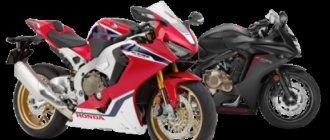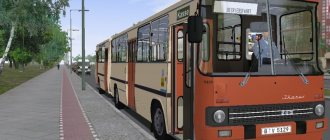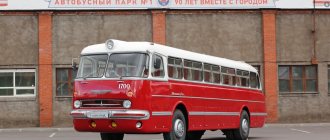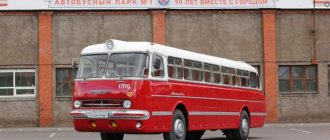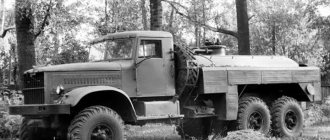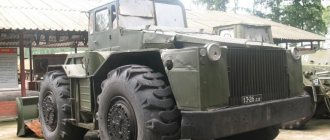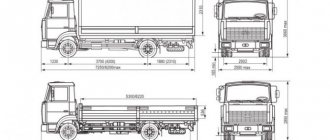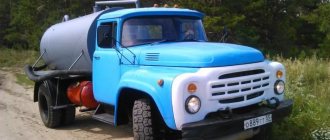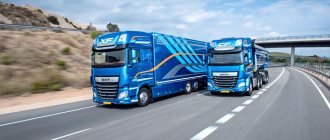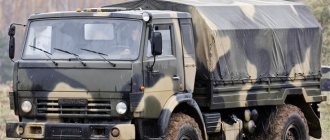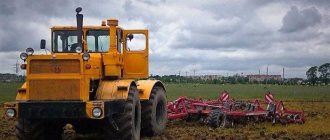P. Aleshin
The cross-country ability of this truck, which has been in production for over 30 years, can still be called outstanding. The path to its creation was long and difficult, but everyone who worked behind the wheel of these all-terrain vehicles remembers them with kind words. Numerous versions of the ZIL-157 model could be found in the Far North, and on construction sites in Siberia, and on pipeline laying in Central Asia, and, of course, in the armies of many countries around the world. Undoubtedly, this was one of the worthy domestic developments, and it deserves to be remembered.
At the end of the 1930s, when the inevitability of World War II was beyond doubt, designers of European factories producing army vehicles were racking their brains over how to increase the cross-country ability of vehicles. Their efforts did not go unnoticed in the USSR, because serious attention was paid to issues of increasing defense capability. The greatest successes in this matter were achieved at the Gorky Automobile Plant, where constant velocity joints were first introduced into production, turning the front axle of a car into a drive axle. The merit of the design team under the leadership of Andrei Aleksandrovich Lipgart lies in the fact that, having tested various two-axle and three-axle trucks, they proved that all-wheel drive vehicles should have single-pitch tires, tires with a special tread for various driving conditions on the terrain, special weight distribution along the axles, etc. It’s a pity that the war prevented the implementation of plans to produce a family of all-terrain vehicles, and after the war the country received only one two-axle all-wheel drive truck, the GAZ-63, although it had unique cross-country ability.
At the Moscow Automobile Plant named after. Before the war, Stalin managed to produce a small batch of ZIS-32 two-axle off-road trucks. At the end of the 1940s, designers sought to create the Soviet Studebaker US 6x6, taking as a basis its technical features and based on the units of the new 4-ton ZIS-150 truck. As you know, these legendary all-terrain vehicles with gable rear wheels proved themselves to be excellent in battles with the Nazis, including as carriers of the famous Katyusha launchers.
The three-axle ZIS-151, to the great chagrin of its creators, turned out to be much worse than the Studebaker. Put into production in April 1948, a year later, during a long run on the spring off-road, it was significantly inferior in cross-country ability to both the Lend Lease prototype and the GAZ-63 all-terrain vehicles, which more than once had to pull ZIS vehicles out of mud and snow captivity. Heavy vehicles (the weight of the ZIS-151 exceeded the weight of the Studebaker by a ton) with small wheels and insufficient ground clearance, low-power engines and rear axles with double tires were nicknamed “irons” among testers, forcing drivers to remove the second ramps and push the stuck one. car with another car, fortunately the design of the special rear bumpers allowed this. In the memoirs of the testers, one can read that thick liquid mud easily covered the rear wheels, turning them into four barrels, spinning helplessly in the mud mass. Removing the outer slopes covered with mud, picking out the dirt with a crowbar, was a real pain, but this was necessary to increase cross-country ability. Gable wheels required more power from the engine, as they laid additional tracks, while on the GAZ-63 the rear wheels walked exactly along the track of the front ones.
Car history
The impressively sized truck from the Likhachev plant was labeled “ZIL-157”. The world saw the new product in 1958 at an automotive exhibition in Brussels, France. The first modifications of the car appeared in the same year, rolling off the assembly lines of the plant of the same name.
Then the model was used both for civilian needs and for the army. The drawings were designed based on the already existing ZIS-151 model, but with significant modifications. It was from this model that the cabin layout was taken and subsequently with improved elements.
After four years of production, the car was improved and the load was redistributed along the axles, as a result the index changed to “ZIL-157K”. In 1978, the truck conveyor was moved to the Ural Automotive Plant, and the model itself acquired an even longer name “ZIL-157KD”.
In this form, production continued until 1994. The car, more than ever, was and remains relevant for our roads, since the cross-country ability of a car with three axles is excellent.
More than 20 years have passed since production ceased, but the car still carries out its difficult service in many departments of the national economy. Hobbyists restore old cars and sometimes find the most unusual uses for this retro model.
Device
ZIL-157 is equipped with a 5-speed gearbox with synchronizers in second, third, fourth and fifth gears. The transfer case is characterized by a 2-shaft design. The single-stage final drive is equipped with spiral teeth. The car's axles are noticeably different from its predecessor ZIS-151. The front axle is equipped with Bendix-Weiss constant velocity joints. The driver could turn it off if desired. Each axle has a propeller shaft, and the braking system is designed for all wheels and is complemented by a pneumatic drive.
The ZIL-157 cab has received a number of improvements that add comfort to the operator’s work. Thanks to the shortened hills, the impact force transmitted to the steering wheel from the wheels when the truck is moving has been noticeably reduced. Improved shock absorbers added smoothness to the car. The designers did not forget about the comfort of movement in winter. A water radiator with an electric motor maintained normal temperature inside the car even in severe frosts. The cabin was also equipped with an additional glass blowing system.
The driver's seat, characterized by a comfortable fit, is adjustable. Over the years of production, the ZIL-157 cabin has undergone minor changes, while maintaining the original characteristics. It was an all-metal structure and allowed free space for the driver and two passengers. There was a round hatch on the roof.
The all-wheel drive system and single-pitch tires significantly increased the cross-country ability of the model. It is no coincidence that the car was used for military purposes for a long time.
ZIL-157 was an excellent base for installing various modifications of bodies with standard and strictly specialized purposes. This added versatility to the model and ultimately made it one of the most common in the USSR. A variety of tanks, repair shops, vans, snow removal equipment, ladders and other installations were mounted on the truck chassis. The most popular versions are those with flatbed bodies.
In terms of characteristics, ZIL-157 remained among the market leaders for a long time. However, they no longer correspond to the modern automotive industry. The model is a thing of the past, but its use has not completely ended. In the regions, the car continues to be used. The truck’s ability to conquer hard-to-reach areas is especially appreciated.
Cabin and body
The model had body sides with the ability to open on three sides, which facilitated the loading/unloading process. The ZIL-157 gained particular popularity in the Soviet army due to its cross-country ability and high endurance levels - this explains its widespread distribution.
In the cabin of the previous model, the driver could not count on comfortable work; the seating position was uncomfortable, there was no heater, and ventilation was poor. In addition, the driver's hands were subject to noticeable impacts transmitted from the wheels.
On the new truck, the designers tried, if not to completely get rid of the shortcomings, then at least partially improve the ergonomics of the cab and steering. The driver's seat, characterized by a comfortable fit, is adjustable.
Over the years of production, the ZIL-157 cabin has undergone minor changes, while maintaining the original characteristics. It was an all-metal structure and allowed free space for the driver and two passengers.
There was a round hatch on the roof. The list of items on the all-terrain truck's instrument panel included a turn switch, windshield wiper valve, radiator shutter control handle, brake and tire pressure gauges, and a small instrument panel. The speedometer took pride of place on the larger dial.
Other sensors and indicators of the machine’s operating systems:
- Cooling system temperature sensor;
- Ammeter;
- Fuel tank level indicator;
- Pressure gauge for monitoring the lubrication system;
- Lamp for monitoring high beam headlights;
- Turn signal indicator lamp;
- Two dashboard lighting lamps.
Under the panel there is a block of taps for adjusting tire pressure. To control the truck, the cab is equipped with gas, clutch and brake pedals, a starter pedal, and a foot light switch.
There were also levers for the handbrake, gear shift, front axle engagement, and winch control. The appearance of the car was also interesting. The elongated and slightly pointed buffer part, wide flat wings, single-pitch wheels - everything was extremely harmonious.
The three-seater cabin was more than 2 meters high and had no windows. Round headlights were located on the side wings and were protected by a metal grille. The main color was khaki, since most of the cars were produced for the needs of the USSR army.
The car body was a wooden platform covered with longitudinal metal ribs that protected it from abrasion. The sides were assembled from wooden plates 20 mm thick and 80 mm wide.
For strength, the longitudinal structure was reinforced with transverse bars with metal brackets. The front side was fixedly attached, and the side and rear sides were folded back, thereby completely opening the body platform. Thus, loading and unloading military and any other property was carried out easily and quickly.
Start of production
The history of the creation of cars in the USSR has a difficult beginning. In the early 40s, when the outbreak of World War II was no longer in doubt, designers of the world's automobile factories were looking for a solution to improve army equipment. The USSR did not stand aside, because improving defense capability was a priority.
Then, thanks to the team of designers at the machine-building plant named after. Gorky, under the leadership of A. A. Lipgart, an event took place that turned the concept of automobile construction upside down. Namely, after all kinds of tests, they began producing trucks with constant velocity joints, thanks to which the front axle of a vehicle turned into a drive axle. Also, according to the theory of designers, all-wheel drive vehicles should have tires with special treads for all kinds of terrain conditions.
Cars must be produced with a special weight distribution along the axles. Further development of all-terrain vehicles ceased due to the outbreak of war. But this did not stop us from launching the production of the GAZ-63 truck, the only two-axle all-wheel drive SUV with unique cross-country ability.
Automobile plant named after Stalin in the pre-war years began producing two-axle ZIS-32 trucks, which at that time were distinguished by increased cross-country ability. And in the post-war period, the plant's designers began working on an analogue of the American Studebaker, using the ZIS-151 as a basis.
Since the Soviet truck performed well during the war, including as a carrier of the famous Katyusha launchers, the choice was obvious. But to the great disappointment of automobile creators, the ZIS-151 was much inferior to its American counterpart. This was confirmed during an off-road run in the spring of 1949.
Since the army placed its primary hopes on super-passable trucks, all errors and shortcomings had to be corrected in a short time. So in 1950, on the basis of the ZIS-151, the production of the BTR-152 armored personnel carriers was launched, but with single-pitch tires on all wheels with larger tires.
A project was also implemented to introduce a system for centralized control of air pressure in tires. This made it possible to significantly increase the truck’s cross-country ability on different types of terrain. But as the tire pressure decreased, the speed of the SUV also decreased.
Of course, having the ability to regulate tire pressure had more advantages.
When tire pressure decreases:
- Deformation increases and specific pressure on the ground decreases.
- The rut depth decreases.
- Energy costs for rutting are reduced.
- The soil resistance to wheel movement is reduced.
The driver, using a centralized system, could change the tire pressure even while driving. The military really liked this know-how, as it significantly increased the service life of the vehicle. Plus, if a tire was damaged, the movement of the SUV could not be interrupted, since the inflation system balanced the drop in air pressure in it.
Specifications
The technical indicators of the ZIL-157, despite the fact that the model appeared in Soviet times, remain relevant today. The truck is used in Altai, the Far North, Central Asia, Ukraine and other countries not only in the post-Soviet space. Moreover, the key advantage of the vehicle is its high cross-country ability.
Power unit
The ZIL-157 engine, technical characteristics and internal filling of the car were changed.
The six-cylinder engine was installed on a new aluminum alloy head, the carburetor was changed, and the cooling system was improved. A new oil pump and a redesign of the crankshaft seals modernized the lubrication system. Engine
| Type | ZIL-157 |
| Number of cylinders | 6 |
| Cylinder arrangement | Row |
| Compression ratio | 6,2 |
| Cylinder operating order | 1-5-3-6-2-4 |
| Working system volume | 5.5 liters |
| Power | 104 l. With. |
| Fuel type | Petrol |
| Fuel consumption. N liters per 100 kilometers | ~40 |
| Maximum rpm | 2 600 |
| Carburetor | K-88AZH |
Transmission
The car was originally equipped with a five-speed gearbox, where the fifth gear was an overdrive, but after 1961 it was removed. The transfer case taken as a basis from the ZIS-151 received wear-resistant gears, new seals and forced engagement.
The cardan drive was completely redesigned; an intermediate support for the rear axle cardan was mounted on the middle axle.
The axle housings of the drive axles were significantly strengthened, wheel hubs and brakes of a new design were installed, and the wheels began to be mounted on eight studs. Transmission
| Gearbox type | Mechanics | |
| Number of steps | 6 (5 – forward; 1 – backward) | |
| Synchronizers | Between 2-3 and 4-5 steps | |
| Cardan drive | Pneumatics | |
| Gear ratios of gearbox stages | Fifth | 0,81 |
| Fourth | 1,00 | |
| Third | 1,89 | |
| Second | 3,32 | |
| First | 6,24 | |
| Reverse | 6,70 | |
| Cardan transmission ratios | First | 2,44 |
| Second | 1,24 | |
| Main gear of drive axles | 6,67 | |
A D245-12S diesel engine was installed on trial.
Dimensions and wheels
The wheelbase of the car has undergone significant reconstruction. Instead of the ten that were on the ZIS-151, there were only six wheels. And instead of two spares there was now one. New tires have been specially developed, the inner layers of which are made of soft rubber, the profile width has been increased, and the number of cord layers has been reduced.
The tire pressure had a centralized system, controlled directly from the driver's seat. The ZIL 157 wheels had a deep directional tread, which virtually eliminated slipping.
For the first time in the domestic automotive industry, an inflation system was installed on a truck to regulate tire pressure.
Punctures and small holes in the wheels no longer affected the speed of the car; the compressor automatically pumped in the required amount of air, compensating for the lack of pressure. It was also possible to turn on the pumping mechanism from the driver's seat. Dimensions
| Length | 6,684 mm |
| Width | 2,090 mm |
| Height | 2 360 mm |
| Front axle clearance | 310 mm |
| Ground clearance of the middle and rear axle | 350 mm |
| Wheelbase | 4 225 mm |
| Ford depth | 650 mm |
| Turning radius | 11.2-12 meters |
For more comfortable driving on various surfaces (swamps, sand, etc.), it was possible to change the tire pressure, increasing it and, when overcoming an obstacle, returning it to normal. It is noteworthy that all processes could be carried out on the go.
Load capacity
- The maximum load according to the passport is 4.5 tons;
- Trailer – 2.5 tons;
- The weight of the vehicle when fully equipped is 5,540 kilograms.
Modifications
- ZIL-157 – standard version;
- ZIL-157V – classic truck tractor;
- ZIL-157K – basic version since 1961;
- ZIL-157KV – basic truck tractor since 1961;
- ZIL-157Yu – tropical modification;
- ZIL-157G – model with shielded equipment;
- ZIL-157KG - version with shielded equipment, which entered the series in 1961;
- ZIL-157E – export modification;
- ZIL-157E - a special version, equipped with two gas tanks with a total capacity of 300 liters;
- ZIL-157KD - basic version since 1978;
- ZIL-157KDV is the basic truck tractor since 1978.
- PMZ-27 – fire engine. Wide rear doors were designed especially for this modification for the convenience of the rescue team.
At one time, data on improvements to the model were not available for review. “ZIL 157”, photos of which were not published anywhere, was classified, like any military equipment of that time.
Modifications
More than 10 variants were produced on the base 157th ZIL under the following indexes:
- B - truck tractor;
- K - basic version improved in 1961;
- KV - truck tractor, developed in 1961;
- D - option using shielded electrical equipment for protection against radio interference and radar detection equipment;
- KG - modification of 1961 using shielded electrical equipment based on version K;
- KD - a variant from the Ural plant, which received an improved carburetor, appeared in 1978;
- KDV - truck tractor 1978;
- E - special version, equipped with 2 fuel tanks of 150 l each;
- E - transport for delivery to the Warsaw Pact countries;
- Yu is a car with a modified cooling system and a larger radiator for use in tropical climates.
ZIL-157 KDM is an experimental flatbed truck manufactured in 1984 with a ZIL-157KD engine and transmission, a ZIL-130 and ZIL-131 cab, a ZIL-131 frame and platform. But prototypes are not limited to the ZIL-157KDM; for example, in 1962, the ZIL-157KV1 was manufactured - a truck tractor for working with semi-trailers.
Dump truck
The dump truck units of the Mytishchi plant decided to adapt a dump truck on the ZIL-157KD chassis. The prototype ZIL-MMZ-4510 was built in 1988. It received a metal platform with a dump mechanism and a hydraulic pump. Tests revealed a number of problems, as a result, dump trucks were produced in a small batch for army needs.
Timber truck
The timber carrier was not produced serially. However, due to its carrying capacity, the ZIL-157 has found wide use among loggers. The truck is durable, can overcome wetlands and areas with difficult terrain, conscientiously hauling round timber from clearings.
Firefighter
The ZIL hose fire truck was named AR-2. It has an enlarged fire brigade cab and wide rear doors. The fire truck is equipped with a 4.5-ton water tank and a telescopic ladder. Can work in the most difficult to reach places.
Gasoline tanker
ATZ-3-157 is a fuel tanker, which began to be produced back in 1958. In 1959, the VMZ-ZIL-157 army water and oil tanker appeared, in which one tanker was designed for 1400 liters of water, the other for 700 liters of oil. ATsMM-4-157K is a fuel and oil tanker built in 1962 with a capacity of 250 liters of technical oil.
Bus
Based on the chassis of the 157th model, a cabover staff bus was produced for the needs of the Western Group of Forces in Germany.
Advantages and disadvantages
The parameters of the main components and assemblies of the ZIL 157 met the highest requirements of that time. Since the vehicle was produced for the Soviet Army, no expense was spared in its production. Thus, the ZIL 157, the characteristics of which did not need improvements, but had only some shortcomings, was assembled on an assembly line according to the classical scheme, without changing technology for years.
- The main disadvantage of the car is the lack of hydraulic power steering, but this does not significantly affect the popularity of the truck in the domestic market.
- Single-pitch wheels with a 6X6 formula and the ability to regulate pressure had a positive effect on the truck’s increased cross-country ability - there are no barriers for it even in modern times.
- The truck was equipped with a winch for self-pulling. This distinguished the car favorably from its progenitor.
- The cabin could be heated in winter and ventilated in summer - for cars of the sixties this was real progress.
- For the ZIL-157, fuel consumption per 100 km is 42 liters of gasoline*, which is a rather bad side of the car.
- Despite the simplicity of the design and high service life, the “off-road king” sometimes breaks down. However, current owners of the all-terrain vehicle should not worry; spare parts for the ZIL 157 are on sale in sufficient quantities.
*in extreme cold conditions, consumption increases.
Wheels
In order to create a real all-terrain vehicle, the designers had to work not only on the power unit and suspension of the van, but also on the tires. For the first time, an automatic tire pressure adjustment system was installed on a truck. The tires themselves were made using completely new technology. It was decided to increase the profile of the tires, increase their elasticity by reducing the number of cord threads and using softer types of rubber.
The truck's cross-country ability increased significantly, but the weakened tire design was making itself felt. Tire life has decreased significantly, especially if the van was used exclusively off-road.
Let's sum it up
In total, almost 798 thousand vehicle data were collected over the years of production. The use of the ZIL-157 car made an invaluable contribution to the development of the country's economy. Not many of these trucks have survived to this day, but they still exist. Most of it is for the personal use of individual entrepreneurs and small businesses. Nowadays, there is even such a type of service as renting a car for extreme sports enthusiasts, so that they can test the qualities of a truck in dangerous and difficult terrain.
And this service is in quite wide demand. Some are attracted by nostalgic memories, while others are simply attracted by the thrill. Considering all of the above, the ZIL-157 has not yet outlived its usefulness, moreover, it is not going to retire. The price of the version from the 80s of the last century ranges from 50,000 to 80,000 rubles. The latest versions from the 90s with mileage cost an average of 120,000 - 150,000 rubles.
We advise you to read the article: ZIL - the history of the auto giant
Engine
ZIL-157 was improved several times, receiving new power plants. Initially, the truck was equipped with a 6-cylinder block with an aluminum head. With a working volume of 5.5 liters, the engine developed a power of 104 hp. The maximum torque of this unit was 334 Nm. Additionally, the engine had a radiator that cooled it using a 6-blade fan. The ZIL-157 also received a modernized crankshaft oil seal and oil pump, which improved the lubrication system. The service life of the power plant was increased by improving the suspension of the unit.
In winter, the car required special care, since the cooling system behaved quite capriciously. In some cases, it was necessary to put insulating casings on the radiator.
ZIL-157 photo
Read further:
UAZ - unique SUVs with a legendary history
KAMAZ - cars of the era
Mini history
Jaguar XK120
Skoda 422 from the 30s
Buick history
Features of operation
Almost eight hundred thousand vehicles produced were used for military and peaceful purposes. Civilian vehicles "Truman" (one of the popular names for a truck) were used to transport goods and people in deep off-road conditions, in forestry enterprises, remote farms, as the special equipment described above.
Military trucks transported personnel and weapons. Truck tractors transported artillery installations. It was practiced to use the vehicle for sapper and engineering units.
Despite the subsequent development of more advanced models, the ZIL-157 continued to be used even after the model was no longer produced. It can still be found on the roads today.
